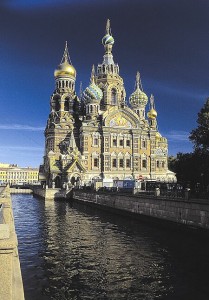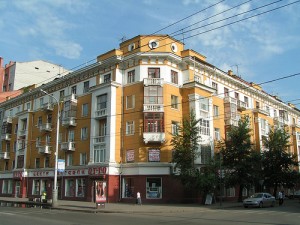Russian Architecture
Russian architecture, and the beauty of the majestic buildings it has produced, has mainly been influenced by religion throughout the history of the Russian nation. By virtue of its size and magnitude, Russian architecture is nearly recognizable to most people. Its domes, icons and baroque style are familiar to most and unique to its style.
Churches have been predominantly the only buildings made of stone, and are therefore the only buildings still standing from the past. The most common characteristics of Russian architecture are onion shaped domes, sharply sloping roofs, and tent shaped spires. The onion shaped dome has become almost a uniquely distinguishing feature of Russian architecture. The domes sit upon a tall pillar which is meant to mimic the shape of a candle. Ancient Russian people believed that this candle like structure would simulate a flame of faith that would reach all the way up to heaven. However, for practical purposes, the domes were useful in allowing rain to fall and not collect on the roofs, as well as to prevent the build-up of snow.
The first characteristic ‘onion’ dome was built on the Cathedral of Sancta Sophia in Novgorod. The cathedral was built in the eleventh century and inside, the main feature is the “iconostasis.” This is a type of altar in which the churches main icons are erected in order of their hierarchy. Formerly an Orthodox basilica, the Cathedral served as the cathedral of Constantinople from the 4th century until about 1453. For a fifty seven year period from 1204 to 1261, the cathedral was changed to a Roman Catholic Church under the Constantinople rule.
Known for its massive dome, the cathedral is one of the jewels of Byzantine architecture, and for almost one thousand years, the Sancta Sophia was the largest cathedral in the world, until the Seville Cathedral was finished in 1520. Inside, the structure is covered with mosaics, marbles, pillars and artistic decoration. Today, the Sancta Sophia is still considered one of the greatest Byzantine structures of all time.
During the Middle Ages, architecture in Russia seemed to follow the shift from the old Russian cities, toward a combination of Russian influences and classical Renaissance styles. The Assumption Cathedral in Moscow is most likely the first example of this foreign influence. Designed by Bolognese architect Aristotele Fioravanti, the Cathedral is symbiosis of traditional Russian architecture, and influences of classical Renaissance architecture. Ivan the First tried twice to build a cathedral, only to have the first become dilapidated and beyond repair, and the second barely off the ground was destroyed by an earthquake. So, Ivan III finally asked Fioravanti to come and build the church and he started from scratch with the intention of using Russian traditions. The result was a masterpiece that combined both traditional Russian architecture and classical Renaissance style. Colorful and majestic frescos adorned the cathedral on the ceilings, walls and pillars that stand inside for support. (Frescos are paintings done on a moist surface with paint that is ground up in water.)
Russian influence would receive a rebirth of sorts under Ivan the Terrible. It was under his reign that the Cathedral of St. Basil’s in Moscow was constructed, and it is considered to be one of the greatest sights in Russia, definitely the most famous site in Red Square. Ivan commissioned the structure in order to celebrate his military victory in 1552 over the Tatar rule of Kazan. The construction of the Cathedral took five years, from 1555 to 1560. The use of color, shapes and textures in this building lie in stark contrast to the Assumption Cathedral. The cathedral shows roots of classic architecture, as well as modern and bold influences of the architect.
Perhaps the greatest shift back to a more European influence in design was under the reign of Peter the Great. The Peter and Paul Cathedral, designed by architect Domenico Trezzini, was built with a largely baroque influence and was a huge departure from the typical classic Russian Orthodox style seen in past centuries.
In recent decades, Russian architecture has taken a turn back toward the traditional Russian orthodox style. But now, there is no formal rule or governance of style, since the dissolution of the Russian state. Therefore, Russia has seen somewhat of an explosion of skyscraper and ‘modern’ types of structures, as opposed to strictly traditional and classic Russian buildings.



